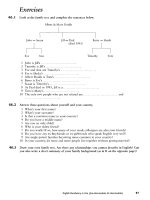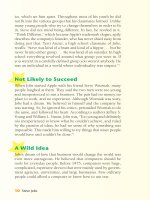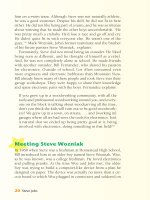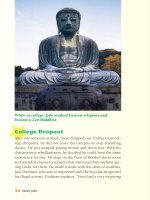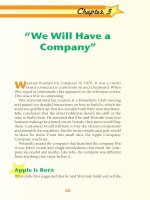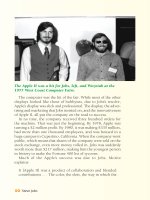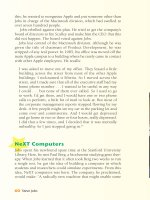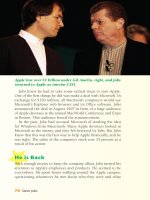Steve Jobs.Other books in the People in the News series phần 5 pdf
Bạn đang xem bản rút gọn của tài liệu. Xem và tải ngay bản đầy đủ của tài liệu tại đây (1.31 MB, 10 trang )
40
Chapter 3
“We Will Have a
Company”
W
ozniak finished his computer in 1976. It was a circuit
board connected to a television set and a keyboard. When
Woz typed in commands, they appeared on the television screen.
This was a first in computing.
Woz demonstrated his creation at a Homebrew Club meeting
and passed out detailed instructions on how to build it, which the
audience grabbed up. But few actually built their own machines.
Jobs concluded that the other hobbyists lacked the skill or the
time to build them. He reasoned that if he and Wozniak went into
business making the printed circuit boards, their peers would buy
them. Customers would still have to buy the various components
and assemble the machines, but the most complicated part would
be done for them. From this small idea, the Apple Computer
Company was born.
Wozniak created the computer that launched the company. But
it was Jobs’s vision and single-mindedness that made the com-
pany successful and quirky. Like Jobs, the company was different
from anything that came before it.
Apple is Born
When Jobs first suggested that he and Wozniak build and sell the
“We Will Have a Company”
41
circuit boards, Woz was reluctant to do so. He had no thoughts
of starting a business, getting rich, or changing the world. Nor,
did he see how such a business could make money. Although he
was not materialistic, he did not have money to lose. But Jobs,
with his typical intensity, was sure there was a need for such a
business. Electronic hobbyists, he insisted, would buy the device.
And, if the business failed, at least they could say that they had
tried.
Wozniak recalls:
His idea was for us to make these preprinted circuit boards
for $20 and sell them for $40 . . . Frankly, I couldn’t see
how we would earn our money back. I figured we’d have to
invest about $1000 . . . To get the money back, we’d have
to sell the board for $40 to fifty people. And I didn’t think
there were fifty people at Homebrew who’d buy the board.
. . . But Steve had a good argument. . . . He said—and I can
Jobs and Wozniak agreed to sell circuit boards that Woz
created under the name Apple Computers in 1976.
42
Steve Jobs
remember him saying this like it was yesterday: “Well, even
if we lose our money, we’ll have a company. For once in our
lives, we’ll have a company.” . . . That convinced me. And
I was excited to think about us like that. To be two best
friends starting a company. Wow. I knew right then that I’d
do it. How could I not?
34
Once the two agreed on selling the circuit boards, they had to
come up with a name for the company. Jobs, who had recently
visited the All One Farm, suggested Apple Computers. He wanted
a name that did not sound too technical and would attract every-
day people. Wozniak liked the name. On April 1, 1976, Apple
Computers was born.
Personal Computers
T
he earliest personal computer was the Altair 8800. Ed
Roberts created the first one in his garage in Albuquerque,
New Mexico, in 1975. It arrived as a kit that buyers had to
assemble. It had no keyboard, monitor, printer, or mouse,
and only 250 bytes of memory. That is about the amount of
memory a modern computer uses to store one sentence.
The Altair 8800 had switches on a front panel and lights
on the back. The user flipped the switches to program the
computer. For example, to add two plus two, the user had to
flip eight switches for each two, and nine switches for plus.
The third light on the left indicated the answer four.
Although Altair 8800 could not do much, hobbyists liked
the challenge of entering commands and seeing if their pro-
gram actually worked. Two teenagers named Bill Gates and
Paul Allen developed a programming language called BASIC,
which allowed users to load the program on paper tape right
into the computer rather than flipping switches. This made
computers easier to operate and made it possible for them
to do more.
“We Will Have a Company”
43
The First Apple Computer
Starting a new company was not easy, especially for two young
men whose only business experience was selling illegal blue
boxes. They had to come up with enough money to produce
the computers, which they named Apple I. So, Jobs sold his van
for $1,000, while Wozniak sold his calculator for $250. Jobs
also took a job at the local mall, which required him to dress
up as characters from Alice in Wonderland and shake customers’
hands.
The two planned to build fifty printed circuit boards in all.
Then Jobs got an order for fifty fully assembled computers from
a local electronics store worth $25,000. The store’s owner, Paul
Terrell, had seen Wozniak demonstrating his invention at a
Homebrew Club meeting. He liked what he saw and told Jobs
to stay in touch. Jobs’s idea of staying in touch was going to
Terrell’s store the very next morning. Terrell was not enthusiastic
about stocking just the circuit boards, but he thought he could
sell fully assembled computers. Even though this was not their
original plan, Jobs took the order. “That was the biggest single
episode in the company’s history,” explains Wozniak. “Nothing
in subsequent years was so great and so unexpected. It was not
what we had intended to do.”
35
The Apple I computer was sold for $666.66 in 1976.
44
Steve Jobs
Producing fifty fully assembled computers meant that Jobs
and Wozniak not only had to supply the finished boards but
also buy all the components and parts, and put the machines
together. With so many computers to make, it was not practical
to build the boards by hand. The two decided to have them mass-
produced by a manufacturing company. Then, Jobs and Wozniak
would plug in the computer chips and do the wiring themselves.
However, Woz’s graphic representation for the circuit board was
hard for the manufacturer to follow. Jobs hired Ron Wayne, an
Atari engineer, to draw the schematics based on Wozniak’s plans,
and also to design an owner’s manual. Since they had no money
to pay Wayne, they offered him 10 percent of the company.
Wayne did not stay with the company long. He sold back his
shares, which become worth $65 million four years later, for
$300.
Wayne doubted that Jobs and Wozniak could come up with
enough money to pay for all the supplies they needed and the
company would fail. Jobs proved Wayne wrong. He convinced a
local electronics supply company to give him parts for thirty days
on credit. At the same time, he worked out a deal with Terrell
to be paid cash upon delivery of the computers. Each machine
cost $220 to make. Terrell paid $500 per unit. When Terrell paid
Jobs, Jobs used half the cash to pay off the electronic company. In
essence, Jobs got Terrell to finance the operation without Terrell
knowing he was doing so. Jobs then plowed their profits back
into the business.
A Family Affair
Jobs also kept the location of the company’s headquarters under
wraps. Unable to afford to rent a space, the boys used the Jobs’s
garage. To make the business seem more professional Jobs got a
post office box and an answering service, which kept potential
customers from knowing just how modest the business actually
was.
The garage was a hub of activity. Wozniak, who was still work-
ing at Hewlett Packard, stayed up nights working on the comput-
“We Will Have a Company”
45
ers, while Jobs spent his days picking up the finished boards from
the manufacturer and acquiring supplies. He spent his nights
helping Wozniak.
They hired their old friend Bill Fernandez to help them. He was
Apple’s first employee. Soon, Jobs’s sister, Patty, and Dan Kottke
were added to the company’s payroll. Paul and Clara Jobs helped,
too. The group worked round the clock. Patty, Fernandez, and
Kottke attached the components to the boards with Jobs’s help.
They were paid one dollar per board. Wozniak tested each com-
pleted board by plugging it into a television set and a keyboard. If
there was a problem, he corrected it. From the start, Jobs insisted
they use only the best components. While other hobby comput-
ers were using static memory chips that used a lot of power, he
was adamant that Apple utilize a new chip with dynamic RAM
(random access memory or the memory available on a computer).
It used up much less power than the old-fashioned chips. Other
hobbyists criticized Apple for using the chips, which were more
expensive than the static chips. But Jobs was right about their
value. Apple I was the first personal computer to use the chips,
which eventually became the industry standard. “Steve was push-
ing to use the right parts,” Wozniak explains. “We were lucky to
be on the right track. It was one of the luckiest technology steps
on the whole development.”
36
In addition to his other duties, Jobs went to dozens of electron-
ics stores trying to sell Apple I. With his typical determination, he
often would not leave until the manager agreed to stock at least
one machine. In this manner, he managed to sell 150 additional
computers, which he and Woz priced at $666.66. They had no
idea of the number’s Satanic connection (Satan is sometimes rep-
resented by the number 666), picking it because they liked the
repeating digits.
Improving Apple I
Apple I was very different from modern computers. It was
more a computer kit than a complete computer. It had no key-
board, case, or television monitor. Buyers had to supply these
46
Steve Jobs
features. It stored data on a cassette tape, and it produced only
black and white text and graphics.
Even before Wozniak finished designing the machine, he start-
ed thinking of ways to improve it. He wanted his next computer,
which he and Jobs named Apple II, to support color, sound, and
high-resolution graphics. He also wanted the machine to have
slots in the back, which would allow the memory to be expanded.
Jobs had ideas, too. He wanted to replace the cassette tape with
a floppy disk, a new invention that he had heard about. He was
so adamant that Apple II should keep up with new trends that he
got a sample floppy disk for Woz to study and re-create. “Steve
was always looking for new technologies that had an advantage
and were likely to be the trend,”
37
Wozniak explains.
But more than that, he envisioned a future in which comput-
Jobs wanted the Apple II to have top of the line technology,
including a floppy disk instead of a cassette.
“We Will Have a Company”
47
ers would become as common and as useful as telephones. Every
person would have at least one. At the time, this was considered
a wild idea. But Jobs firmly believed in his vision, and he had a
plan to achieve it.
He was convinced that if Apple could build fully assembled,
easy to use computers the company would change the world.
Jobs explains:
The Apple I took us over a big hurdle, but a lot of people
who wanted to use the product were unable to. We were
getting some feedback from a fairly small sample—maybe
40, 50 people. We were hearing from dealers too. They’d
say, “I think I can sell 10 times more of these if you would
just put a case and keyboard around it.” That’s what a lot of
the direction for Apple II came from. If there hadn’t been
an Apple I, there would not have been an Apple II. The
first product solved some of the problems and exposed the
remaining ones in a much clearer light. But we were going
on common sense. . . . We were thinking we should build a
computer you could just roll out of the box.
38
Presentation, Design, and
Marketing
Jobs and Wozniak showed Apple I and a mock-up for Apple II
at the Personal Computer Festival in Atlantic City, New Jersey, in
the summer of 1976. It was the machine’s first national exposure.
Their display, which was perched on a wobbly old card table in a
dark corner, garnered little attention. The experience made a big
impression on Jobs. He realized that if they were going to sell their
computers to everyone, not just hobbyists, presentation, design,
and marketing were important. With this in mind, he insisted
that Apple II be self-contained, meaning it would come with a
monitor, case, and keyboard, and that it be small, lightweight,
quiet, and attractive. He wanted it to look like a household appli-
ance that the average person would feel comfortable using. To this
48
Steve Jobs
Jobs learned that marketing was a
vital aspect to selling the Apple II.
“We Will Have a Company”
49
end, he insisted that the computer should be housed in a molded
plastic case, which, at the time, was more expensive than metal
or wood. But, he believed it would make the machine look sleek
and modern. Then, he hired industrial designer Jerry Manock to
redesign Apple II to fit his vision. He also prodded Woz to give
the computer a lightweight power supply that did not need cool-
ing. This would eliminate the need for a fan, making the machine
quieter. Finally, he hired an advertising firm to come up with the
colorful Apple logo, which has become so recognizable. Then,
he kept the firm on to launch an advertising campaign for Apple,
which included an ad in Playboy Magazine.
Doing all this required more money than Apple had. Jobs went
to banks, Atari, and Hewlett Packard looking for an investor. His
youth, long hair, and hippie attire did not instill confidence in the
business people he propositioned, and he was repeatedly turned
down. Finally, he met Mike Markkula. Markkula was a thirty-
four-year-old retiree, who had made millions of dollars working
as a marketing executive for Intel, the computer chip manufac-
turer. An individualist himself, he was able to look beyond Jobs’s
appearance. When Jobs told him about Apple II and his vision
for the future, Markkula was hooked. He provided Apple with
$92,000, in exchange for a third of the company. As part of his
role at Apple, Markkula developed a business plan, which was
vital to getting the company off the ground. From the start, he
said he would stay with Apple for only four years, and then he
would go back into retirement.
The West Coast Computer Faire
In order to get Apple II finished in time for the April 1977 West
Coast Computer Faire, Apple added more employees, many of
whom worked round the clock. The machine was worth the
effort. It was the first easy to use computer ever made. It had
color, high-resolution graphics, sound, and a place to attach game
paddles. It was also the first computer to have a programming
language built into it. For years to come, other computer manu-
facturers copied it.

